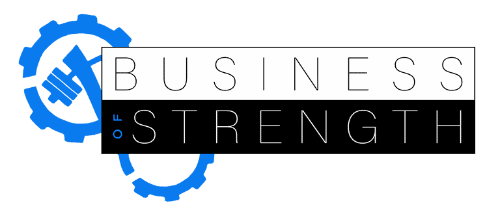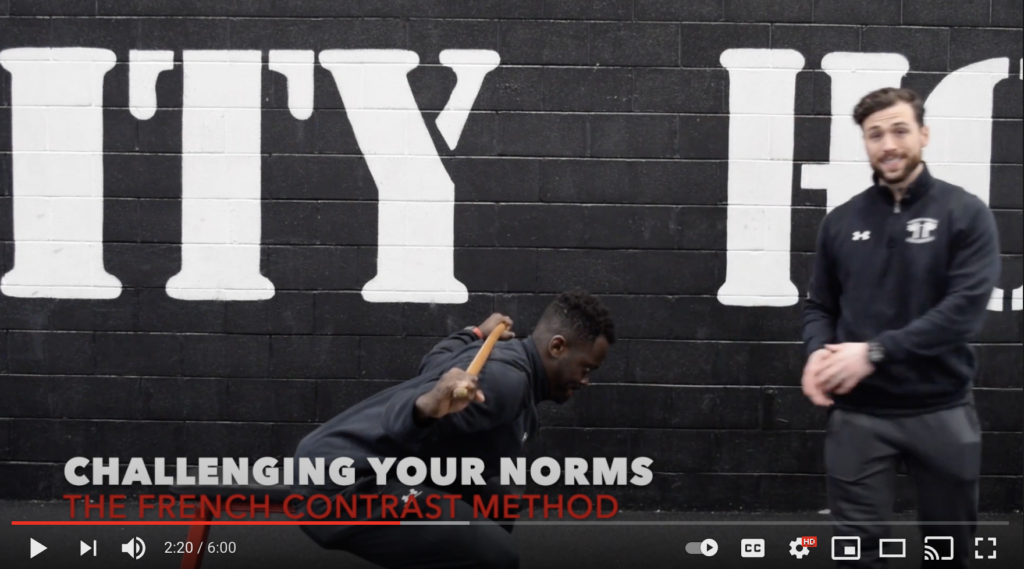Rethinking Your Approach to French Contrast Training
by Adam Menner
Eastern literature has been a significant reference point in the realm of strength and conditioning. They have greater experience and empirical findings than we do here in the United States.
We often take when they say as law, given their experience. However, I challenge you to look deeper, I challenge you to take an objective viewpoint.
One of the most popular eastern european strength training methods, is known as the French Contrast Method.
The French Contrast was created by track and field coach, Gilles Cometti, and made popular by Cal Dietz and Ben Peterson in their book, Triphasic Training.
Each method mentioned above has two SIGNIFICANTLY different athletic actions.
Lifting weights and performing athletic movements are two completely separate physical actions.
What Happens When An Athlete Lifts Weights?
- Extension
- Sympathetic Tone
- VM – Bracing
- Spinal Compression
- External Rotation
- Loss of Feeling of the Ground (No reference point)
What Happens When An Athlete Performs an Athletic Action (Sprint or Jump)?
- Inside Edge of Foot
- Relaxation
- Internal Rotation of Lower Extremity
- Spinal Waving
- Spinal Decompression
What is the French Contrast Method?
This advanced method is designed to apply more stress on the athlete to elicit greater neurological and physiological adaptation to maximize explosive strength and speed endurance.
It uses two styles of training to promote these adaptations.
1 Complex Method: A heavy compound exercise followed by a plyometric movement that is biomechanically similar, such as a Squat and a Squat Jump.
2 Contrast Method: A heavy set followed by an explosive exercise that is typically deloaded, meaning you use assistance on the move.
The combination of exercises increases the amount of muscle fibers that are recruited to perform a movement, as well as the speed at which those fibers are recruited. This increases the speed at which your muscles can produce force (i.e., rate of force development), explosive strength and speed endurance.
Each method mentioned above has two SIGNIFICANTLY different athletic actions.
Lifting weights and performing athletic movements are two completely separate physical actions.
In this YouTube Video, Clich Here – we talk about the differences.
When Thinking of “Bracing for Strength” We Often Think of Intra-Abdominal Pressure (The Valsalva Maneuver)
The valsalva maneuver was named for Antonio Valsalva, an 18th-century physician. Used as a way to evaluate the cardiovascular system, it is often done, both consciously and unconsciously, by those engaged in vigorous movement; especially where those movements encounter resistance, as with strength training. Described simply, the valsalva maneuver is a forced expiration against a closed glottis.
The “KIA” in karate can be compared to the modified valsalva maneuver, which is the technique most lifters use. Any unconscious grunt under exertion likewise can be compared to this technique. It is NOT holding one’s breath and completely holding one’s breath during heavy weight lifting, in this writer’s opinion, should never be recommended. Instead, we use this “modified” technique in which the glottis is partially closed in order to maintain more pressure during the most difficult portion of the lift. Some air is allowed to escape in a controlled way. Your breath should be allowed to release quickly just upon passing the ‘sticking point’ of the lift.
The valsalva maneuver helps to increase intrathoracic and intra-abdominal pressure. With resistance training and lifting, it is this intra-abdominal pressure we are concerned with. This increase in pressure results in decreased venous return and reduced cardiac output. The heart rate speeds up and vasoconstriction increases so that blood pressure is maintained. If intense and prolonged enough you may become lightheaded or even faint due to lack of oxygen in the brain. Also, when the pressure is released, blood pressure can sky rocket due to the vasoconstriction and high cardiac output.
What is the Valsalva Maneuvers Purpose?
Increased intra-abdominal pressure during lifting or other exertion has been referred to as a “fluid ball”, which is a rigid compartment of fluid in the lower torso. This increases the rigidity of the torso and helps to support the vertebral column. This is basically similar to the effect of a weight belt but naturally produced in the body, much to our benefit. The purpose of the valsalva maneuver during lifting is to increase this intra-abdominal pressure.
Many authoritative sources claim that using the valsalva is necessary to bring this about, including such books as Essentials of Strength Training and Conditioning. According to Stuart McGill, this “fluid ball” is a natural and automatic response of the body under heavy load. The valsalva maneuver (VM) just helps to increase this pressure. And indeed this claim is borne out by a great deal of clinical data.
Understanding more about what happens abdominally when you lift a heavy load may help. During heavy lifting activities or vigorous exercise, such as deadlifts, squats, or even demanding barbell curls or situps, both the abdominal muscles and the diaphragm help to stabilize the spine. When they contract, intra abdominal pressure is increased and this increase decreases the compressive force on the spine while helping to stabilize the torso. The diaphragm is pushed up into the thoracic cavity (chest cavity) so that intrathoracic pressure is also increased. If you are not blocking air from escaping your lungs by closing your glottis, this increase in intrathoracic pressure will force air out of the lungs. If your glottis is closed, thus blocking air from escaping and thus decreasing the pressure, a valsalva is being performed. This also increases your blood pressure and this causes the left ventricle of your heart to have to work much harder to push blood into circulation.
Clinically, the VM is considered to have four phases.
1) A temporary rise in mean arterial blood pressure as a result of the increased intrathoracic pressure
2
a) A fall in atrial filling pressure leading to a decrease in mean arterial blood pressure.
b) An increase in sympathetic activation which increases peripheral vascular resistance so mean arterial blood pressure rises a small amount once again and heart rate increases a bit.
3) The strain is released and mean arterial blood pressure falls suddenly as the intrathoracic pressure falls.
4) The increased sympathetic tone and systemic vascular resistance is persistent so there is an overshoot in mean arterial blood pressure. This results in a reflexive slowing of the heart rate (bradycardia) and both blood pressure and heart rate return to normal. 3
If you’ve ever experienced an exertional headache, for instance, during barbell squats, this may be one cause of it. But it is important to note that resistance exercise causes acute increases in blood pressure regardless if someone holds his/her breath during a lift. This is temporary and, according to research, has no long term effect on resting blood pressure. Also, this transitory increase in blood pressure becomes blunted in trained individuals compared to untrained ones. 4 The valsalva maneuver does not change this and some of the dire warnings against the maneuver are a bit unfounded.
Contrary to popular belief, higher peak blood pressures are associated with submaximal high volume lifting more than with maximal lifting. During the last few reps of high volume sets the pressure reaches its peak, regardless of valsalva maneuver use although the valsalva is associated with even higher peaks. However, the valsalva is really not necessary for such submaximal training and would be difficult since oxygen deprivation and the need to breathe in a regular way is contrary to its performance. It is exactly for this reason that most trainers teach trainees to breathe in during the eccentric and out during the concentric as a simple way to maintain breathing during the kind of resistance training most people engage in, which entails lighter weights and moderate to high volume.
I should point out that although huge increases in blood pressure have been recorded during resistance training and even more during the valsalva maneuver there is nothing to indicate a negative effect on resting blood pressure. Things quickly normalize and return to baseline. And indeed, resistance training seems to lead to lower blood pressure than that of sedentary individuals, especially in men.
Contrarily, when looking at what the core’s true role is in human function, we see something completely different.
What is the Real Role of the Core?
Cueing the Core Required Components
- Anchoring of Ribs to Pelvis.
- No excessive anterior pelvic tilt
- 360 Degree expansion during inhalation
- Eccentric abdominal contraction
- A functional core is measured by the body’s ability to hold the ribs and pelvis together.
- This is done primarily with the abdominals, however there are several other muscles that assist this process and can also be classified as part of the core.
The body needs to be able to hold the core together and maintain its integrity throughout movement and respiration. The core should be able to reset the body back to neutral whenever we change our position. Your ability to maintain core integrity will be directly proportional to general health and performance.
Unusual Cues For the Core
Exhalation
This is designed to make sure our entire abdominal wall is contracted and the anchoring has been activated. a. Exhale completely b. You should have no air left in your lungs c. You should be spitting air out at the end of the exhale d. Imagine you made a million dollars for every CC of air you exhaled. Now how much can you exhale?
Inhalation: This is designed to make sure the core does not fall apart when you inhale
Use your hands to make sure that your abs are still on
Imagine that at any time during this exercise I may punch you in the stomach. Make sure your abs are protecting you.
You should be able to feel expansion in your back when you inhale.
Make sure you are not extending your back during the inhale
Make sure you are breathing into your stomach i. we do not encourage belly breathing but while the core is contracted, breathing into the belly encourages training an eccentric abdominal contraction.
Extra Help
Bend your knees. This allows the hips to unlock. If the client is overly extended, they may need a little help to reset their pelvis. Bending the knees will allow the hips to posteriorly tilt and return to neutral.
Reach your hands forward when you inhale it. Air needs to have a place to go if you are closing off the stomach by contracting your abs. Reaching your hands/arms forward gives it a place to go. It will now be able to travel to your posterior mediastinum for expansion.
My Objective Viewpoint
We’ve been told, the role of the core is to protect the lumbar spine when extremities are in motion.
I would even go so far as to say that any muscle that attaches to the pelvis or ribcage and is being used with the intent to move or stabilize those structures can be identified as a core muscle respective to the movement. Sure the hamstrings, hip flexors, and adductors control the femur BUT we also know that they can orientate and stabilize the pelvis as well.
Muscles are incredibly dynamic and can serve many different functions given the appropriate respective intent, and because of this I’ve begun looking at intent respective to orientation rather than solely at traditional muscular function.
To brace or not to brace?
That is the question.
Intra-abdominal pressure can be a hot-button issue, but it doesn’t have to be.
What is usually the purpose of bracing? To create pressure within the abdominal cavity and create as much “stiffness” as humanly possible to lift the most weight as you can and/or prevent injuries.
The issue with bracing, especially a Valsalva-like strategy where you hold in an inhale, is that it takes away our sense of the ground. This is not a quality we want to train.
The internal pressure displaced by the movement of the descending central tendon of the diaphragm enables us to sense and feel the ground if we maintain the ability to exhale.
It is from competent rib cage position with that the diaphragm can work with the abdominals to fill out chest and lateral-posterior rib cage with air.
Therefore, if we can’t exhale due to a poor bracing strategy, we are holding our anterior rib cage in external rotation and our system cannot stay grounded with ability to alternate from a protracted to retracted state. This prevents us from being able to balance tonic and phasic muscular activity during exercises.
𝐓𝐡𝐞 𝐠𝐨𝐨𝐝 𝐧𝐞𝐰𝐬 𝐢𝐬 𝐭𝐡𝐚𝐭 𝐢𝐟 𝐨𝐮𝐫 𝐫𝐢𝐛𝐜𝐚𝐠𝐞 𝐢𝐬 𝐩𝐨𝐬𝐢𝐭𝐢𝐨𝐧𝐞𝐝 𝐢𝐧 𝐚𝐧 𝐨𝐩𝐭𝐢𝐦𝐚𝐥 𝐩𝐨𝐬𝐢𝐭𝐢𝐨𝐧 𝐨𝐯𝐞𝐫 𝐚 𝐧𝐞𝐮𝐭𝐫𝐚𝐥 𝐩𝐞𝐥𝐯𝐢𝐬 (𝐫𝐞𝐥𝐚𝐭𝐢𝐯𝐞 𝐭𝐨 𝐭𝐡𝐞 𝐥𝐢𝐟𝐭 𝐲𝐨𝐮 𝐚𝐫𝐞 𝐞𝐱𝐞𝐜𝐮𝐭𝐢𝐧𝐠), 𝐲𝐨𝐮 𝐩𝐫𝐨𝐛𝐚𝐛𝐥𝐲 𝐝𝐨𝐧’𝐭 𝐧𝐞𝐞𝐝 𝐭𝐨 𝐰𝐨𝐫𝐫𝐲.
As with all athletic tasks we are trying to perform – it’s important to look at what outcome you are trying to achieve.
Every outcome has an “optimal” strategy.
Removing yourself from your ideologies and biases will allow you to see that everything works – depedning on the goal.
In this article, I wanted to present the opposing viewpoints to the French Contrast Method.



